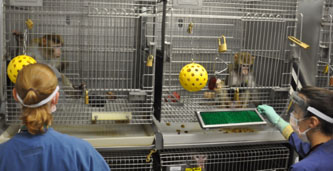Behavioral Management and Animal Welfare
One element of the Emory National Primate Research Center's (EPC) extensive Animal Care program is Behavioral Management, which applies science-based care to provide for the psychological well-being of our center's nonhuman primates (NHPs). Our behavioral management personnel regularly publish their research findings and teach internally as well as nationally and internationally to help those who care for NHPs in research settings, zoos and sanctuaries do so based on the latest data and best practices.
Behavioral Management Mission
Promote, maintain and measure NHP well-being through collaboration with the center's Veterinary Medicine, Animal Care, Colony Management and Research departments.
Objectives
- Promote species-appropriate and natural behaviors in the animals
- Prevent or treat behavioral problems
For each NHP, behavioral management staff members assess behavior, use the results to improve individual NHP well-being as well that of the entire colony, implement several behavioral management techniques concurrently (see below), apply science-based training methods and customize the approach to the needs of each animal. Techniques vary based on species, age, social history and temperament, along with requirements of research protocols. Emory's Institutional Animal Care and Use Committee's Environmental Enrichment for Nonhuman Primates policies and procedures (PDF) help guide employees to bestserve the needs of the animals in research, which enhances the value of EPC science to improve human and animal health and lives.
Animal Welfare Science
Behavioral Management personnel conduct scientific research to advance understanding of the welfare of NHPs living in a research setting. This research is conducted in real time while we implement a comprehehsive Behavioral Management program that includes:
- Social Housing
- Environmental Enrichment and
- Positive Reinforcement Training
This combination ensures program effectiveness, makes best use of center resources and helps EPC personnel regularly incorporate recent developments in animal welfare science.
1. Social Housing
Social Housing is the cornerstone of Behavioral Management and is the primary method EPC employees use to support NHP welfare. Because NHPs are social animals and form complex social relationships, the EPC socially houses the majority of our center’s NHPs, gives them indoor/outdoor access and facilitates their social interactions with other behavioral management techniques.
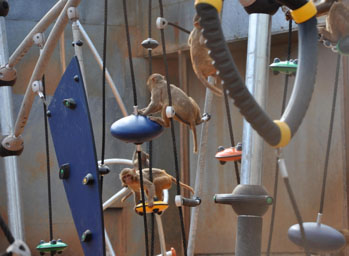
2. Environmental Enrichment
Environmental Enrichment encompasses a variety of methods to encourage the expression of species-appropriate behaviors, such as searching for and processing foods, exploring, manipulating and participating in physical activities, including climbing, running and jumping. Environmental enrichment can also help reduce and even prevent behavioral problems. Our feeding enrichment program focuses on increasing the time NHPs spend foraging and eating a variety of healthy and novel foods. We give our NHPs food puzzles and other devices that require effort, manipulation and problem solving, which extends feeding times in a species-appropriate manner. We also give a variety of foods throughout each day, such as popcorn, cereals, yogurt, salsa and fresh produce, including lettuces, herbs, cucumbers, onions, bananas and apples. Physical enrichment promotes active behavior, such as play, manipulation and increased activity, as well as rest. Play and manipulation may be with toys, paper and cardboard to encourage exploration, and increased activity may include swings and complex climbing structures that encourage jumping, running, climbing and social play. Rest may involve shaded areas and perches. Also included within Environmental Enrichment is occupational enrichment and sensory enrichment.
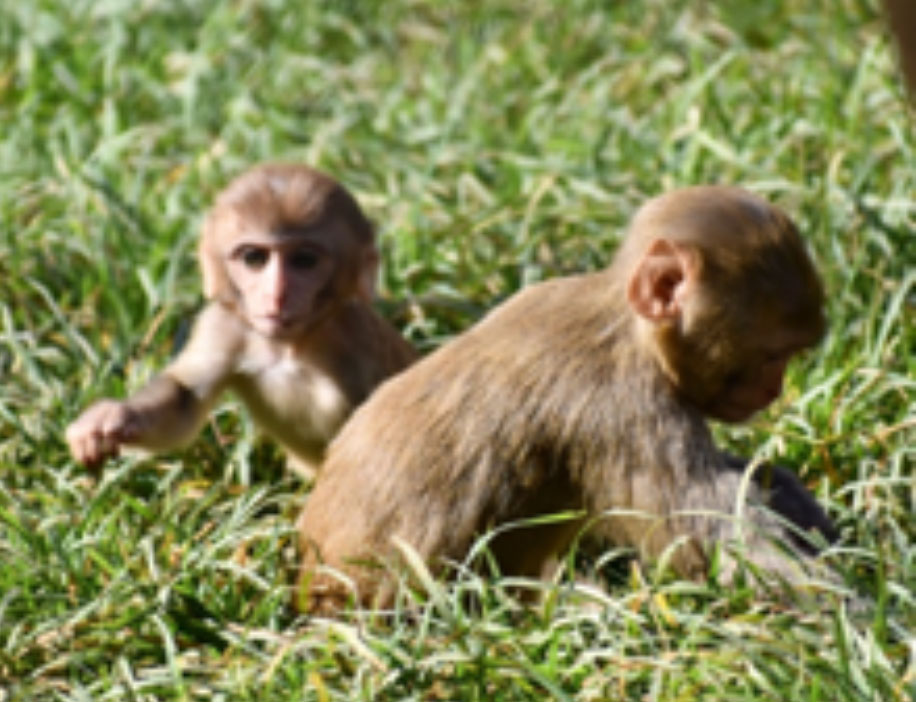
Occupational Enrichment
Occupational enrichment creates problem-solving situations and includes computerized learning opportunities as well as food puzzles and toys that require the NHPs to use tools to remove hidden foods.
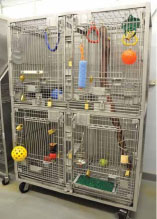
Sensory Enrichment
Sensory enrichment items can be physical, auditory or visual, such as mirrors to enhance visual stimulation and classical music and nature sounds and scenes for the NHPs to hear and watch. We also offer natural and soft substrates, such as fleece, wood chips and wood blocks. In warmer months, we add water-based enrichment, such as pools, misters, ice cubes and ice blocks.
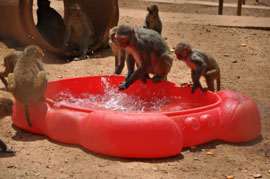
3. Positive Reinforcement Training
Animal training emphasizes Positive Reinforcement Training techniques to teach primates to assist with daily care (husbandry), veterinary and research procedures. We give the animals rewards for behaviors that facilitate their care and research participation. Examples of such behaviors are moving (shifting) into a different enclosure so we can clean their housing areas and stepping onto a scale so we can check weights. Positive reinforcement training relies on the NHPs voluntarily participating, which gives them more control over the environment and reduces potential stress associated with routine procedures.
